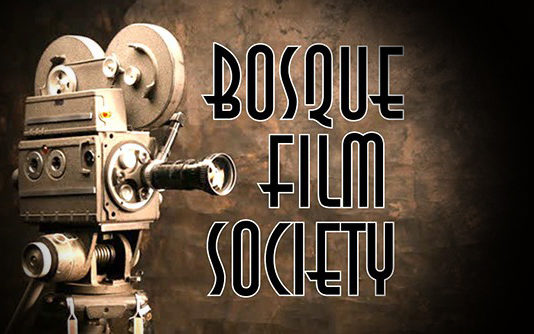Bosque Film Society produces its first short film “Gal Manns Skrik,” garners nominations and wins in Texas, national and international film festival circuits
By SIMONE WICHERS-VOSS
Bosque Film Society Founding Board Member
It all started as a casual suggestion by Bosque Film Society founding board member and filmmaker-in-residence Matt Wallace. As the non-profit society was planning its first free four-day movie weekend with 2021 Halloween Free Film Fest at the historic Cliftex Theatre in Clifton, Wallace thought it might be fun to produce a horror short film to show the public.
Wallace probably should have opened with “only a mad man would come up with this project” to embark on such an ambitious creative undertaking less than a month before Oct. 30. But he had no doubt that founding board president Brett Voss, a man with endless energy and a bucket list item to check off, would take the bait – hook, line and sinker.
Not a man to be weighed down by practicalities or shy away from a challenge, Voss’ creative brain began producing ideas within moments. The how, with whom, when, where and time crunch were just mere inconveniences as the seed grew to write, shoot and produce a short film entitled, Gal Manns Skrik: Mad Man’s Scream.
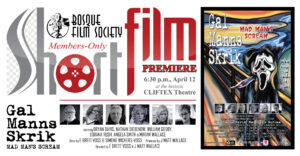 Together with his wife and partner in crime for all his projects, Voss started brainstorming to develop a storyline by asking board members to submit a favorite horror/thriller movie scene. Bringing the area’s Norwegian heritage and the “it’s a bit mad” statement together was Norwegian painter Edvard Munch’s 1893 masterpiece, The Scream.
Together with his wife and partner in crime for all his projects, Voss started brainstorming to develop a storyline by asking board members to submit a favorite horror/thriller movie scene. Bringing the area’s Norwegian heritage and the “it’s a bit mad” statement together was Norwegian painter Edvard Munch’s 1893 masterpiece, The Scream.
Slowly but surely, the idea developed to very loosely re-imagine scenes from Stanley Kubrick’s 1980 The Shining, George A. Romero’s 1968 Night of the Living Dead, Alfred Hitchcock’s 1960 Psycho, Roman Polanski’s 1968 Rosemary’s Baby, Jonathan Demme’s 1991 The Silence of the Lambs, and Wes Craven’s 1996 Scream, putting to use classic thriller cinematography techniques – the use of edgy black-and-white as an example – and ample sound design effects.
Why these iconic scenes? Beginning with an extensive list, the scenes were chosen by the budding film crew in a round table discussion developing the storyline. With that in mind, let’s take a glance at each one.
From The Shining, the crew selected the “all work and no play makes Jack a dull boy” scene, also known as “the typewriter scene,” when his wife discovers her husband’s work is nothing but gibberish and a sign of his mental deterioration, which becomes a shocking and pivotal moment of the movie.
Night of the Living Dead might not be the first-ever zombie film, but it unquestionably ranks as the godfather of the slew of zombie movies that followed in its wake.
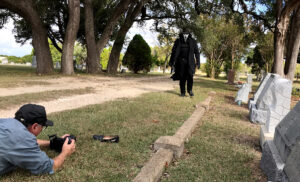 Hitchcock’s Psycho shower scene, which runs just three minutes and involves 50 quick cuts, stands out as the most-watched scene, not only in horror, but in all of film history. As actress Janet Leigh starts to take a peaceful shower and wash off all her stress, we see an anonymous figure approach from behind the blurry murk of the shower curtain. It rips the curtain off its holders and proceeds to stab Leigh to death as Bernard Herrmann’s unforgettable screeching-violin composition called “Murder” amplifies the terror.
Hitchcock’s Psycho shower scene, which runs just three minutes and involves 50 quick cuts, stands out as the most-watched scene, not only in horror, but in all of film history. As actress Janet Leigh starts to take a peaceful shower and wash off all her stress, we see an anonymous figure approach from behind the blurry murk of the shower curtain. It rips the curtain off its holders and proceeds to stab Leigh to death as Bernard Herrmann’s unforgettable screeching-violin composition called “Murder” amplifies the terror.
The first time we meet Hannibal Lecter in The Silence of the Lambs, he tells Clarice, “A census taker once tried to test me. I ate his liver with some fava beans and a nice Chianti.”
Wes Craven’s Scream takes the classic slasher movie template and makes it so much more. Consequently, the first scene of the film, ranks the most iconic horror movie opening and the most quoted of all time. Alone in the house, Drew Barrymore’s character is making popcorn when she receives a call from a strange man who asks her if she likes scary movies. The iconic Scream mask remains a very popular Halloween costume.
In Rosemary’s Baby, Mia Farrow finally sees her baby after being told it had been stillborn. While the baby is never shown to the audience, Rosemary is horrified. She screams “what did you do to his eyes?” Her neighbors assure her that nothing is wrong with the baby, and that he has his father’s eyes – revealing to Rosemary that Satan, not her husband, is the father of her child.
With the scenes selected and a basic concept in mind, Voss began to write a script, piecing these scenes together cohesively, something Voss happened to have some experience in. Representing one of many projects over the years, Voss wrote a feature length script while teaching film appreciation and video production at Temple High School, ultimately producing and directing the film using a mixture of high school, college and community stage actors.
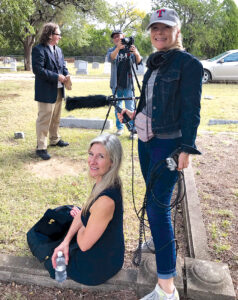 “It was so much fun with this bunch of multi-talented people who had never worked on a film before,” Voss said. “Matt and I have always talked about working on a film project together, and this proved to be the perfect vehicle. But admittedly, it grew into something far bigger and much better than we ever expected.”
“It was so much fun with this bunch of multi-talented people who had never worked on a film before,” Voss said. “Matt and I have always talked about working on a film project together, and this proved to be the perfect vehicle. But admittedly, it grew into something far bigger and much better than we ever expected.”
The Bosque Film Society film observes a weary writer battling to meet his deadline to complete a manuscript in the late night/early morning hours. As the overwrought writer labors away at his typewriter, glimpses of the developing novel are revealed – or are they?
Together with an enthusiastic crew of BFS board members with no budget whatsoever using borrowed equipment from Mustang International and Southern Cross Creative, the first steps to making the thriller short film began. Wallace, with his extensive filmmaking experience served as director of photography, co-director and producer. As the principal writer and visionary, Voss served as co-director and associate producer. Both guided the crew with their new and unfamiliar roles, whether as actor or as support crew.
During the first day of shooting, BFS founding board secretary Nathan Diebenow somewhat uncomfortably, but gallantly stepped into the spotlight as an actor in the first scene shot at the Walnut Springs Cemetery. In later scenes, he proved to be an excellent sound and boom assistant, a role he thoroughly enjoyed.
The cemetery scene introduces the audience to the ominous Skrik – Norwegian for “scream.”
After the shoot at the cemetery, long-time Tin Building Theater actress Lorana Rush joined Bryan Davis and Miriam Wallace at the Davis residence to re-imagine the Rosemary’s Baby scene.
During Day Two of shooting, the kitchen scene very loosely based on several lines from The Silence of the Lambs was shot at the Clifton Civic Center kitchen and The Shining scenes with the author played by Will Godby were shot at the Legacy Park rock building known as the “Little Alamo.”
In the third and final day of shooting, founding vice president Angela Smith quickly deserved the nickname “one take Angela” thanks to her ability to translate the director’s scene explanation into an excellent performance every time. Nevertheless, the reinterpretation of the Psycho shower scene kept her cold and wet for hours due to the many different angles that were needed to recreate the feel of the iconic scene at the Goodall-Witcher Fitness Center.
 Skrik – played by four different people – and “the author at the typewriter” are the red thread in the short that tie the very different scenes together. To recap, yes, the liver was real in the kitchen scene, the corpse was not. Diebenow did a great “Nailed it,” channeling Kevin Costner’s role in The Big Chill. And fun fact, the blood dripping off his fingers was diluted chocolate syrup.
Skrik – played by four different people – and “the author at the typewriter” are the red thread in the short that tie the very different scenes together. To recap, yes, the liver was real in the kitchen scene, the corpse was not. Diebenow did a great “Nailed it,” channeling Kevin Costner’s role in The Big Chill. And fun fact, the blood dripping off his fingers was diluted chocolate syrup.
As much as Wallace and Voss enjoyed the process of directing and filming, they both spent considerable time coaching the crew and cast on the filmmaking process. Everyone experienced “on the job training” – how to start the audio, how to hold the mike, what props to have or make, rehearsing dialogue on the fly as it changed somewhat to the circumstances. Wallace himself had a new video camera and new editing software he was trying out.
With each scene, details became important – from the whiskey bottle, to ingredients and utensils for Skrik to prepare liver in the kitchen, to the bar of soap, dressing up a crib using Skrik’s cloak, making a baby’s head with a bag of pasta, polishing up a tarnished bowie knife to shine, to getting the wrinkles out of the shower curtain, waiting for the sun to come from behind a cloud, making a ream of paper fall correctly, lugging around props, lights, mike booms, and having lots and lots of towels for the shower scene, and a heater to keep the leading lady warm between shot setups.
“Working with a helpful crew is very enjoyable,” Wallace said. “This project confirms that it is worth the time to train and invest in people. Because with the next project, you can rely on them again.”
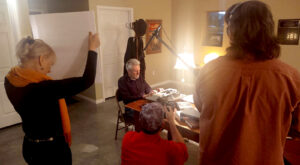 And as they continue to do film projects, the BFS wants to recruit students from the area schools that would be interested in learning hands-on what making a movie, commercial, infomercial is all about. Part of the society’s mission is to actively pursue offering education. Besides giving extra information on films at film appreciation evenings, new film projects offer that opportunity.
And as they continue to do film projects, the BFS wants to recruit students from the area schools that would be interested in learning hands-on what making a movie, commercial, infomercial is all about. Part of the society’s mission is to actively pursue offering education. Besides giving extra information on films at film appreciation evenings, new film projects offer that opportunity.
After hours of shooting footage came the tedious and time-consuming task for Wallace to piece the shots and scenes together, to correct color balance, to add sound effects and add wild lines if there was not enough on the original footage. The team relied heavily on his experience and knowledge as they say in filmmaking “to fix it in post.”
On viewing the raw cut, Godby – with his vast expertise in video editing in Los Angeles and New York City – joined the co-directors to tweak, adapt and polish the film until they felt the end product had the feel and timing of a thriller and was finally ready for viewing. Following private premiere show to Bosque Film Society members at The Cliftex Theatre, the trio deemed the thriller short was worthy of entering a variety of film festivals in state, as well as a few nationally and internationally.
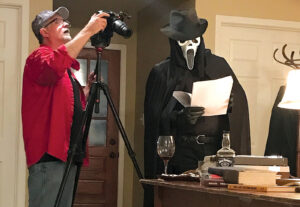 “What we did is how you make real movies,” Wallace said. “It’s a script, then a story board, you shoot film, and then you edit.” Adding to the authenticity and legitimacy, Voss produced an attention-grabbing two-minute trailer, Wallace produced a one-minute trailer for festivals and the co-directors collaborated on a movie poster using parody art from Max McCormack.
“What we did is how you make real movies,” Wallace said. “It’s a script, then a story board, you shoot film, and then you edit.” Adding to the authenticity and legitimacy, Voss produced an attention-grabbing two-minute trailer, Wallace produced a one-minute trailer for festivals and the co-directors collaborated on a movie poster using parody art from Max McCormack.
Ironically, the BFS charter member survey revealed that horror films were their least favorite genre. But technically, this production could be considered more of a thriller.
Speaking of thrills, the cast and crew are absolutely thrilled and proud that their short film has been selected for several film festivals and has even won a couple of awards, even on the international scene. The short won Best Horror Short Film at the Indie Movies Spark Film Festival in Utrecht, the Netherlands and Best Genre Short Film in the Sea of Art International Film Festival in Stavanger, Norway. At the Cowpoke Int’l Film Festival in Electra, the production was nominated for Best Short Film, Best Horror/Thriller, Best Suspense, Best Actor – William Godby and Best Director – E. Brett Voss and J. Matt Wallace. At the San Antonio Texas Short Film Festival, the film received a nomination for Best Experimental Short Film.
With the film festival season just getting started, the directors have become excited about the possibilities after the early returns. These nominations and awards supply the sought after laurels to place on the movie poster.
Be careful what you say around these people. Simple questions like “What keeps you awake at night?” and “Tell me, do you still wake up screaming?” could be enough to get them started on a next project, ready to bark “Quiet on set! Roll camera! Roll audio! Action!”

